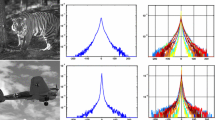Abstract
Atmospheric conditions induced by suspended particles, such as fog and haze, severely alter the scene appearance. Restoring the true scene appearance from a single observation made in such bad weather conditions remains a challenging task due to the inherent ambiguity that arises in the image formation process. In this paper, we introduce a novel Bayesian probabilistic method that jointly estimates the scene albedo and depth from a single foggy image by fully leveraging their latent statistical structures. Our key idea is to model the image with a factorial Markov random field in which the scene albedo and depth are two statistically independent latent layers and to jointly estimate them. We show that we may exploit natural image and depth statistics as priors on these hidden layers and estimate the scene albedo and depth with a canonical expectation maximization algorithm with alternating minimization. We experimentally evaluate the effectiveness of our method on a number of synthetic and real foggy images. The results demonstrate that the method achieves accurate factorization even on challenging scenes for past methods that only constrain and estimate one of the latent variables.
Similar content being viewed by others
References
Boykov, Y., & Kolmogorov, V. (2004). An experimental comparison of min-cut/max-flow algorithms for energy minimization in vision. IEEE Transactions on Pattern Analysis and Machine Intelligence, 26(9), 1124–1137.
Boykov, Y., Veksler, O., & Zabih, R. (2001). Fast approximate energy minimization via graph cuts. IEEE Transactions on Pattern Analysis and Machine Intelligence, 23(11), 1222–1239.
Fattal, R. (2008a) http://www.cs.huji.ac.il/~raananf/projects/defog/index.html.
Fattal, R. (2008b). Single image dehazing. In Proc. of ACM SIGGRAPH (Vol. 27, pp. 1–9).
Grewe, L., & Brooks, R. (1998). Atmospheric attenuation reduction through multi-sensor fusion. In Proc. of SPIE sensor fusion: architectures, algorithms and applications II (Vol. 3376, pp. 102–109).
He, K., Sun, J., & Tang, X. (2009a). http://personal.ie.cuhk.edu.hk/~hkm007/cvpr09/.
He, K., Sun, J., & Tang, X. (2009b). Single image haze removal using dark channel prior. In Proc. of IEEE int’l conf on comp. vision and pattern recognition (Vol. 1).
Kim, J., & Zabih, R. (2002). Factorial Markov random fields. In Proc. of European conf on comp. vision (pp. 321–334).
Klinker, G., Shafer, S., & Kanade, T. (1990). A Physical approach to color image understanding. International Journal of Computer Vision, 4, 7–38.
Kolmogorov, V., & Zabih, R. (2004). What energy functions can be minimized via graph cuts? IEEE Transactions on Pattern Analysis and Machine Intelligence, 26(2), 147–159.
Komodakis, N., & Paragios, N. (2009). Beyond pairwise energies: efficient optimization for higher-order MRFs. In Proc. of IEEE int’l conf on comp. vision and pattern recognition (pp. 2985–2992).
Kopf, J., Neubert, B., Chen, B., Cohen, M., Cohen-Or, D., Deussen, O., Uyttendaele, M., & Lischinski, D. (2008a). http://johanneskopf.de/publications/deep_photo/dehazing/index.html.
Kopf, J., Neubert, B., Chen, B., Cohen, M., Cohen-Or, D., Deussen, O., Uyttendaele, M., & Lischinski, D. (2008b). Deep photo: model-based photograph enhancement and viewing. ACM Transactions on Graphics, 27(5), 116:1–116:10.
Kratz, L., & Nishino, K. (2009). Factorizing scene albedo and depth from a single foggy image. In Proc. of IEEE int’l conf on comp. vision (pp. 1701–1708).
McCartney, E. (1975). Optics of the atmosphere: scattering by molecules and particles. New York: Wiley.
Middleton, W. (1952). Vision through the atmosphere. Toronto: University of Toronto Press.
Narasimhan, S. G., & Nayar, S. K. (2002). Vision and the atmosphere. International Journal of Computer Vision, 48(3), 233–254.
Narasimhan, S., & Nayar, S. (2003a). Shedding light on the weather. In Proc. of IEEE int’l conf on comp. vision and pattern recognition (pp. 665–672).
Narasimhan, S. G., & Nayar, S. K. (2003b). Contrast restoration of weather degraded images. IEEE Transactions on Pattern Analysis and Machine Intelligence, 25(1), 713–724.
Narasimhan, S. G., & Nayar, S. K. (2003c). Interactive (De)weathering of an image using physical models. In ICCV workshop on color and photometric methods in comp. vision (CPMCV).
Narasimhan, S., Wand, C., & Nayar, S. (2002). All the images of an outdoor scene. In Proc. of European conf on comp. vision (pp. 148–162).
Oakley, J., & Satherley, B. (1998). Improving image quality in poor visibility conditions using a physical model for contrast degradation. IEEE Transactions on Image Processing, 7(2), 167–179.
Schechner, Y. (2003). http://webee.technion.ac.il/~yoav/research/instant-dehazing.html.
Schechner, Y., Narasimhan, S., & Nayar, S. (2003). Polarization-based vision through haze. Applied Optics, 42(3), 511–525.
Shafer, S. (1985). Using color to separate reflection components. Color Research and Application, 10(4), 210–218.
Szeliski, R., Zabih, R., Scharstein, D., O Veksler, V. K., Agarwala, A., Tappen, M., & Rother, C. (2008). A comparative study of energy minimization methods for Markov random fields with smoothness-based priors. IEEE Transactions on Pattern Analysis and Machine Intelligence, 30(6), 1068–1080.
Tan, K., & Oakley, J. (2001). Physics-based approach to color image enhancement in poor visibility conditions. Journal of Optical Society America A, 18(10), 2460–2467.
Tan, R. (2008a). http://people.cs.uu.nl/robby/fog/index.html.
Tan, R. (2008b). Visibility in bad weather from a single image. In Proc. of IEEE int’l conf on comp. vision and pattern recognition (pp. 1–8).
Tarel, J. P., & Hautière, N. (2009). Fast visibility restoration from a single color or gray level image. In Proc. of IEEE int’l conf on comp. vision.
Tominaga, S., & Wandell, B. (1989). Standard surface-reflectance model and illuminant estimation. Journal of the Optical Society of America A, 6(4), 576–584.
Author information
Authors and Affiliations
Corresponding author
Rights and permissions
About this article
Cite this article
Nishino, K., Kratz, L. & Lombardi, S. Bayesian Defogging. Int J Comput Vis 98, 263–278 (2012). https://doi.org/10.1007/s11263-011-0508-1
Received:
Accepted:
Published:
Issue Date:
DOI: https://doi.org/10.1007/s11263-011-0508-1




